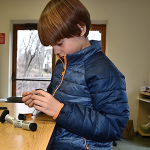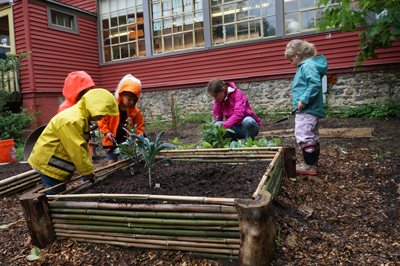Science
Our science curriculum is an adaptable and evolving resource focused on using the scientific process to help students better understand their world. It provides a scaffold for learning experiences while remaining flexible enough to incorporate student interests, new opportunities, and emerging ideas in science education. Its current stage of development is heavily influenced by a variety of sources. These include Miquon’s environment and rich traditions, current research on science literacy, progressive education practices, student interests and the wisdom of our experienced staff.
View The Science Curriculum Scope and Sequence, which uses specific terminology from Project 2061: Benchmarks for Science Literacy, the Pennsylvania Department of Education Standards, and the NYC Department of Education has been used to describe key ideas already in place.
Standing at the entrance of the Bamboo Forest, our campus bird blind has always been a magical place. We`re happy to report that it recently received a major glow up thanks to Miquon counselor and former camper, Vincent Giletto!
Vincent enjoyed using the bird blind for years as a camper, and for his Eagle Scout project, he chose to renovate the space. The numerous improvements he made include installation of new windows, binocular hooks, bird feeders, and a bird bath. He and his team also planted native plants and revived the space with a fresh coat of paint.
We can`t wait for you to bring your own campers here this summer, Vincent. In the meantime, our groups will take good care of your hard work during the school year. And... congratulations on earning your Eagle Scout ranking! (Thanks, @aims912, for all of your help.)
#themiquonschool #miquonsummercamp #ProgressiveEducation #independentschool #phillyschools #phillyfamilies #montcopa #montgomerycountypa #montcoparents #phillysuburbs #conshohocken

Join us this Thursday evening for our next event: "Miquon and Beyond: A Conversation with Alumni."
Stop by at 6:00 pm to learn how the 5th and 6th grade at Miquon prepares children for the transition to middle school and beyond. We`ll hear from the experts themselves: a panel of recent alumni as well as our staff.
Register through the link in bio.
#themiquonschool #ProgressiveEducation #independentschool #montcopa #montgomerycountypa #phillysuburbs #phillyfamilies #phillyschools #conshohockenpa

Need a moment of zen this weekend? View our kindergarteners and first graders’ artwork featured in the Kids Care exhibit of Woodmere Art Museum.
This year’s theme was “My Favorite Place” and our K/1’s contribution showcases children’s favorite places at Miquon. These are places that provide daily comfort to our children and, our hope, is that their representation in story quilt form will provide comfort to someone in the wider community.
This annual program is a collaboration between Woodmere and the Metropolitan Area Neighborhood Nutrition Alliance (MANNA). Read more at the link in our bio.
#themiquonschool #woodmereartmuseum #progressiveeducation #independentschool #phillyfamilies

Hey PA, it’s Election Day!
The 5/6’s theme this year is voting rights. The group is using their newly acquired knowledge of the electoral system to design a school-wide process for electing the very best…. DOUGHNUT!
The 5/6 is still in the primary election phase, but you can glimpse at their process. Today, they were busy filming campaign ads.
Stay tuned for a winner: Will it be Cinnamon Sugar? Will the Stuffed Doughnut Party prevail with Creme Filled Powder? Or will our electorate turn saccharine this year and vote for Fruity Pebbles Chocolate?
#themiquonschool #ProgressiveEducation #Election2024 #ElectionDay #montcopa
#independentschool #phillyfamilies

The heart of Miquon has been restored. Our library is open!
As has been true for quite a while, many children identify the library as their happy place on campus. Thank you to our librarian, Sarah, for the hard work of simultaneously showing our children new worlds through story and providing them with this serene, loving place right here at home.
Here`s to many years of reading books, asking questions, seeking answers, making meaning, and lounging in cozy nooks!
#themiquonschool #progressiveeducation #independentschool #phillyschools #phillyfamilies

Join us this Saturday, November 2 at 10:00 a.m. Meet our head of school, teachers, and current families. We can`t wait to show you how we celebrate childhood from the creek to the classroom.
Register through the link in our bio.
#themiquonschool #progressiveeducation #independentschool #phillyindependentschools #phillyfamilies #openhouse

THE WAIT IS OVER. Our third and fourth graders were finally able to move into their new classrooms last week!
It takes a village to raise a building, we have found. We are so grateful for our little village here in the woods.
Thank you to the many Heart of Miquon donors who made this new building possible. Additionally, thank you to the many hands of teachers, staff, family members, and children who pitched in to move the everyone in.
(Update on the library-section of the building to come next week. For now, check out our 3/4!)
#themiquonschool #heartofmiquon #progressiveeducation #montgomerycountypa #phillyfamilies #independentschool

Each fall, our art room is filled with fresh supplies and butterflies!
Our art teacher, Nicole, explains, “Butterflies are an exciting (and magical) resource to practice our skills of observation. We take time to notice their colors, shapes, patterns, and habits, as we grow our understanding of their importance to our ecosystem.”
After observing butterflies and reading “The Life Cycle of a Butterfly,” by Robin Bernard, young artists created a multi-medium work of art that showcased the life cycle of a monarch.
While this project may be complete, one of Nicole`s goals is aimed at something that goes beyond this work: “In time, our collective care, understanding, and appreciation will help [the monarch butterfly] rebuild their populations and come off of the endangered species list.” Important work for our young artists and change agents!
#themiquonschool #progressiveeducation #naturebasededucation #independentschools #phillyschools #phillyindependentschools #phillyfamilies
![Each fall, our art room is filled with fresh supplies and butterflies!
Our art teacher, Nicole, explains, “Butterflies are an exciting (and magical) resource to practice our skills of observation. We take time to notice their colors, shapes, patterns, and habits, as we grow our understanding of their importance to our ecosystem.”
After observing butterflies and reading “The Life Cycle of a Butterfly,” by Robin Bernard, young artists created a multi-medium work of art that showcased the life cycle of a monarch.
While this project may be complete, one of Nicole's goals is aimed at something that goes beyond this work: “In time, our collective care, understanding, and appreciation will help [the monarch butterfly] rebuild their populations and come off of the endangered species list.” Important work for our young artists and change agents!
#themiquonschool #progressiveeducation #naturebasededucation #independentschools #phillyschools #phillyindependentschools #phillyfamilies](https://miquon.org/wp-content/plugins/instagram-feed-pro/img/placeholder.png)
Approach
To support the development of curious, life long learners, Miquon students actively experiment to better understand the world. The science program emphasizes critical thinking processes that give children the skills they need to explore their own questions.
These essential questions guide the development of worthwhile experiences for Nursery through 6th Grade students:
- How can we observe, question and experiment to better understand our world?
- What lives, grows and breaks down at Miquon?
- How do parts of a system affect each other?
- How can we create what we need or want?
- How does science work? How does science information change over time?
Specific areas of study are selected through the interplay of a variety of factors (including, but not limited to): personal relevance to students’ daily lives, local and global events, the availability of resources, and student and teacher interests. The disciplines of biology, chemistry, physics, ecology, engineering, and art are woven throughout the curriculum. Core ideas in these fields are investigated and revisited in age appropriate ways to build the foundation for a broad and nuanced knowledgebase.
The Art and Science Show
 The Art and Science Show is an event in the spring that showcases work from every child in the school. The art presentation is curated by the students and the art specialist teacher. The science show has had a variety of iterations over the last few years, but it always features reflective learning exhibitions from fifth and sixth grade students. These exhibitions may feature inventions developed by students, extensions of science projects completed earlier in the year, live demonstrations, or creative exhibits that educate visitors about a specific topic. Younger students are also invited to present their projects and inventions, but it is not mandatory.
The Art and Science Show is an event in the spring that showcases work from every child in the school. The art presentation is curated by the students and the art specialist teacher. The science show has had a variety of iterations over the last few years, but it always features reflective learning exhibitions from fifth and sixth grade students. These exhibitions may feature inventions developed by students, extensions of science projects completed earlier in the year, live demonstrations, or creative exhibits that educate visitors about a specific topic. Younger students are also invited to present their projects and inventions, but it is not mandatory.
Science Choice
In addition to scheduled classes, many children also enjoy visiting the science room at lunch choice. The science room is open two to three days a week. Students visit to continue projects from class, build new creations, work with computer programs, read books and spend time with the live animal visitors.
Minicourses
Minicourses are elective courses for children held for an hour on Friday mornings in eight week installments. Topics for these courses may be suggested by teachers or children. Some science related minicourses held over the last few years include: SCRATCH-an introduction to computer programming created by MIT, Google Sites, Woodworking, Art and Sculpture in Nature, Baking Bread, Move It–a dance and fitness class, Bird Watching and Hiking, Paper Airplane Design, Building Things That Go, and Chemistry & Crystals.
Science Blog
Want to learn more about the latest with Science Kate? Check out pictures, kid projects and the other happenings posted to the Science Blog.
Science Blog
- The Miquon Kids’ Research Journal Volume Two
- Spotted Lanternflies and Children
- The Miquon Kids’ Research Journal
Curriculum Report
The curriculum report is the teachers’ review of the entire year, looking back and making observations after their plans, projects, problems, and revelations are long over. One of the distinguishing features of this report is the great extent to which each teacher’s style, focus, and personality come through in this retrospective narrative. Check out the Science Curriculum Report.
